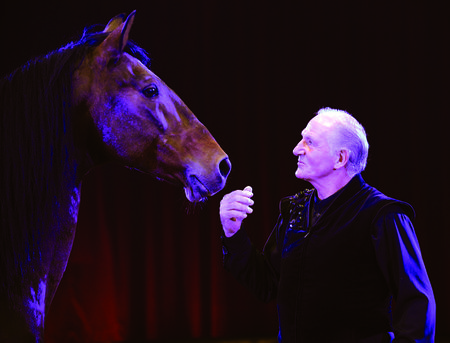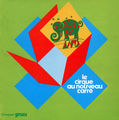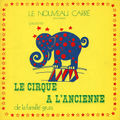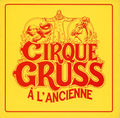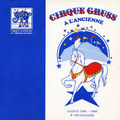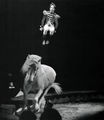Difference between revisions of "Alexis Gruss, Jr"
From Circopedia
(→Image Gallery) |
(→Alexis Gruss's Legacy) |
||
| Line 67: | Line 67: | ||
Evidently, age slowly caught up with Alexis: when he could not perform anymore acrobatics and voltige on horseback, he turned his attention to dressage and to the creation of superb liberty acts. By his own account, he profited in these disciplines from the teachings of his cousin [[Philippe Gruss]] (1935-1996), and to two legends of the equestrian circus, [[Adolph Strassburger]] and [[Otto Schumann]] (not related to the [[The Schumann Dynasty|Schumann]] dynasty), whom he had met in his youth through his uncle Alexis, Sr. | Evidently, age slowly caught up with Alexis: when he could not perform anymore acrobatics and voltige on horseback, he turned his attention to dressage and to the creation of superb liberty acts. By his own account, he profited in these disciplines from the teachings of his cousin [[Philippe Gruss]] (1935-1996), and to two legends of the equestrian circus, [[Adolph Strassburger]] and [[Otto Schumann]] (not related to the [[The Schumann Dynasty|Schumann]] dynasty), whom he had met in his youth through his uncle Alexis, Sr. | ||
| − | As a horse trainer, he largely surpassed his late uncle, Alexis Gruss, Sr., whose talent may have been slightly overstated (Philippe Gruss, his elder son, was in fact the great horse trainer of the family). Like his uncle | + | As a horse trainer, he largely surpassed his late uncle, Alexis Gruss, Sr., whose talent may have been slightly overstated (Philippe Gruss, his elder son, was in fact the great horse trainer of the family). Like his uncle, Alexis Gruss, Jr. received a Gold Clown at the International Circus Festival of Monte Carlo—but more importantly, he became recognized by his peers as the greatest horse trainer of his time. In 2024, the Gold Clown that was presented to Alexis’s grandsons Alexandre and Charles didn't only reward their remarkable juggling act on horseback, but it was also presented as a tribute to Alexis Gruss’s entire family: their equestrian acts were the highlight of this 46th festival. |
Today, the circus is managed by Firmin Gruss, and Stephan, who has inherited his father’s immense creativity, is its artistic director. Maud Gruss, a remarkable tightwire artist like her mother and a gifted equestrienne and horse trainer like her father, oversees the magnificent stables and their 50 stallions of various breeds. The three of them and their children and grandchildren participate in the productions of ''Les Folies Gruss'', a very original concept that is extremely successful in Paris—and in Béziers, which has become the circus's summer home. In 2024, the circus celebrated its fifty years in Paris. | Today, the circus is managed by Firmin Gruss, and Stephan, who has inherited his father’s immense creativity, is its artistic director. Maud Gruss, a remarkable tightwire artist like her mother and a gifted equestrienne and horse trainer like her father, oversees the magnificent stables and their 50 stallions of various breeds. The three of them and their children and grandchildren participate in the productions of ''Les Folies Gruss'', a very original concept that is extremely successful in Paris—and in Béziers, which has become the circus's summer home. In 2024, the circus celebrated its fifty years in Paris. | ||
Latest revision as of 07:08, 15 August 2024
Circus Owner, Equestrian
By Dominique Jando
He had been called "Le seigneur des chevaux" ("The Lord of the Horses"): Alexis Gruss (1944-2024) was for many years France’s leading circus personality, a living legend and a true media star, as well as a distinctively innovative circus creator. Charismatic and multi-talented, he was also recognized as one of the greatest horse trainers of his time, both in the circus world and in equestrian circles.
Early Years
Alexis Jacques André Gruss was born in his parents' living trailer on April 23, 1944, in Bart, a French village near the city of Montbéliard, in the east of France, not far from the Swiss border. He was fourth generation of a circus family of Alsatian and Italian mixed origins. His father was Théophile André Gruss, better known as André or Dédé (1919-2003), a talented bareback rider who became not only a circus director, but also a popular augusteIn a classic European clown team, the comic, red-nosed character, as opposed to the elegant, whiteface Clown.. Alexis’s mother, Hélène Maud (1919-2003), née Lautour, came for the world of traveling menageries.Alexis Gruss grew up in the Cirque Gruss-Jeannet, the circus co-owned and managed by his uncle, Alexis Gruss, Sr. (1909-1985), André Gruss, and their friend Lucien Jeannet (1902-1977), heir to a dynasty of traveling animal trainers; it was one of France’s premier circuses, variously known as Radio-Circus, Medrano Voyageur, Cirque-Zoo Jean Richard, and Grand Cirque de France. There, Alexis, his brother Patrick (b.1950), and his sisters Bella (1948-2012) and Martine (1956-1994) were trained in all circus disciplines by their father and their uncle Alexis—who was to be regarded as France’s leading Equestrian Master.
In 1970, Alexis married Gipsy Bouglione (b. 1947), the daughter of Firmin Bouglione, Sr., a gifted tightwireSee Tight Wire. artist and an outstanding juggler, who was to become one of the most versatile and brilliant circus artists of her generation. In 1969, after a very bad season, Alexis Gruss, Sr. left the Cirque Gruss-Jeannet to join the famous French comedian, actor, and amateur lion trainer Jean Richard, who had just opened his very own circus; two years later, Lucien Jeannet also called it quits.
Left under Alexis and his father’s management, the circus united forces in 1972 with Roger Lanzac, the iconic ringmaster(American, English) The name given today to the old position of Equestrian Director, and by extension, to the presenter of the show. of the French television show La Piste aux Étoiles. Alas, Under the title La Piste d’Or, the new venture didn’t meet with the success they had hoped for, and the show folded before the end of the season. At long last, Alexis convinced André that they should tour under their own name, Gruss—but, after so many different identities, the title Cirque Gruss had no pull. By the summer of 1974, the family enterprise had reached the end of the rope.
Le Cirque à l'Ancienne
By chance, at that time in Paris, the famous actress and theater director Silvia Monfort (1923-1991) had just organized a successful exhibition called Le Cirque en Couleurs ("The Circus in Colors") in her Carré Thorigny theater, and Firmin Bouglione suggested that she add a real circus to her exhibition… It was a loaded suggestion, of course, but since 1974 marked the 200th anniversary of Philip Astley’s first visit to Paris, she thought it was a good idea!
Hence was born Alexis Gruss’s Le Cirque à l’ancienne ("The Old Time Circus"), which performed under a tent tucked in the courtyard of the historic Hôtel Salé (today's Picasso Museum), just opposite Monfort’s theater. Le Cirque à l'Ancienne was an immediate success — a traditional circus with an emphasis on equestrian acts, performed by the very talented and versatile members of a single family: Alexis and Gipsy, Patrick and Sandrine (née Bouglione, then Patrick's wife), Martine, and Dédé, along with two horses, Sultane and Transvaal, and one elephant, Toffy.Alexis did a pas-de-deux on horseback with Martine, a double jockeyClassic equestrian act in which the participants ride standing in various attitudes on a galoping horse, perform various jumps while on the horse, and from the ground to the horse, and perform classic horse-vaulting exercises. with Patrick, a whip and lasso act with Patrick and Martine, presented his elephant Toffy, and performed a clown entrée(French) Clown piece with a dramatic structure, generally in the form of a short story or scene. in whiteface with his father and brother; Gipsy did her tightwireSee Tight Wire. and juggling acts, and Martine was a gracious ballerina on horseback. A magician, Max Hersan, and his daughter Muriel on the rola-bolaA board balancing on one or more cylinders piled on each other, and on which an acrobat stands performing juggling or acrobatic tricks., were added to allow the family members to catch their breath.
At the end of the year, Silvia Monfort was given the direction of the newly created Centre d'Action Culturelle de Paris ("Paris Cultural Center," better known as the Nouveau Carré and, later, Carré Silvia Monfort), and the circus, under Alexis’s direction, became part of its activities, with the addition of the first professional circus school ever opened in the Western World, also under Alexis's artistic direction.
Le Cirque à l’ancienne redirected circus arts to their roots—at a time when French circuses tried in vain to "modernize" themselves with gimmicks not necessarily connected to their true identity and were losing their audiences. Alexis Gruss’s vision had a profound impact on other mavericks’ experimentations that, in time, also proved right and became very successful—such as Circus Roncalli, the Big Apple Circus, and even Cirque du Soleil.
Alexis Gruss liked to repeat this axiom attributed to Gustav Mahler: “Tradition is not the worship of ashes, but the preservation of fire.” (“Tradition ist nicht die Anbetung der Asche, sondern die Weitergabe des Feuers”). He became a circus teacher who passed the flame of his passion on to a new generation of circus artists through his circus school first, and later within his own family.
He always stressed the importance of transmitting one’s knowledge from one generation to the other. He also communicated his work ethic to his students: Practically all of them stressed one central part of the circus education he gave them: "He taught us how to work!" Alexis was a workaholic, a trait that has allowed him to unleash his endless creativity; he had a motto on this subject: "Art is hard work erased by hard work."
From Cirque Gruss to Cirque National
It is impossible to separate Alexis Gruss's life from that of his circus: His circus was indeed his life. Over the years, Le Cirque à l’ancienne evolved; its shows became increasingly creative without ever turning their back to the true circus tradition; they never resorted to "modern" technology or other gimmicks to attract an audience: The sheer quality and novelty of Alexis's creations and the artistry and high level of their acts sufficed to constantly interest the public that, in Paris notably, followed faithfully the family and never ceased being surprised, interested and amazed year after year.By the end of the 1970, the circus had become known simply as Cirque Gruss: The name had finally gained an identity, and a strong one at that. It was synonym of artistic quality, void of commercial afterthoughts, a true circus faithful to its roots and its inherent artistry. The fact that its shows were presented by a homogeneous company, composed mostly of a single family, helped the circus to develop and strengthen its distinctive image.
In the summer of 1977, as the circus was installed in Paris's Jardin d'acclimatation in the Bois de Boulogne, it became the subject of a full-length documentary by the German filmmaker Henrietta Lorch, titled Cirque Gruss (1978)—a precious document on the Cirque Gruss Cirque à l'ancienne of that period, with interviews of Alexis, Gipsy, and Martine Gruss, among others. Another excellent documentary, also titled Cirque Gruss, will be made in 1990 by the French television director and producer Claude Santelli (1923-2001).
In 1998, Alexis's children participated in the International Circus Festival of Monte Carlo: Stephan, Alexis's elder son, and his wife, Nathalie, presented an original pas-de-deux on horseback that earned them a Silver Clown, and Alexis's daughter, Maud, only fifteen years old, performed "The CourierAn equestrian presentation created by Andrew Ducrow in 1827 as ''The Courier of St. Petersburg'', in which a rider stands on two galloping horses, one foot on each, and allows other horses to pass between his mounts, catching their reins as they pass, eventually holding the reins a group of galloping horses in front of him. (Also known in French as ''La Poste''.)" with twelve horses. In all, the family gathered seven Special Prizes. In 2001, Alexis returned to Monte Carlo with his horses, and Prince Rainier III presented him with a Gold Clown—the Circus World's supreme accolade. The entire family and their horses returned again to Monte Carlo in 2016 for the celebration of the 40th festival, which ended with a spectacular presentation by Maud of "The CourierAn equestrian presentation created by Andrew Ducrow in 1827 as ''The Courier of St. Petersburg'', in which a rider stands on two galloping horses, one foot on each, and allows other horses to pass between his mounts, catching their reins as they pass, eventually holding the reins a group of galloping horses in front of him. (Also known in French as ''La Poste''.)" with 17 horses! The Festival invited again Alexis Gruss and his family in 2024 as a the center piece of the event, and honored them with another Gold Clown.
In 1984, Jack Lang, the French culture minister, made it the Cirque National (National Circus), which allowed Alexis Gruss to entirely focus his energies to the creative part of his job—and he delivered superbly, creating a string of original productions built around a theme, such as 1789-1989, Paris-Pékin, De Lautrec à Picasso, etc. Alexis, who was a remarkable musician (a talent he often displayed as a whiteface clownGeneric term for all clowns and augustes. '''Specific:''' In Europe, the elegant, whiteface character who plays the role of the straight man to the Auguste in a clown team.), always let music inspire him, and gave it a growing importance in his productions. This trait would also characterize later his son Stephan's productions.
The circus began to travel internationally with great success. Unfortunately, changes of politics made the government abandon abruptly the "Cirque National" project in 1987. Taken by surprise, Alexis Gruss had to cancel his season, close his circus and reconsider his options. A new project helped him to weather the storm: The film director Claude Lelouch decided to use the Cirque Gruss and the Gruss family in his film L'itinéraire d'un enfant gâté ("Itinerary of a Spoiled Child", 1988), starring Jean-Paul Belmondo.
A New Era
However, by then, Alexis Gruss and his family had well established their reputation, and he was soon able to resume his work without government support. Back in Paris with a new production, La merveilleuse histoire du cirque ("The Wonderful History of The Circus")—which was subsequently invited to the prestigious Festival d'Avignon, one of France's major cultural events—the Cirque Alexis Gruss remained a reference in terms of creativity, as well as for its work for the preservation of the circus’s equestrian traditions.Tragedy struck in 1994 when Armand Gruss, Alexis and Gipsy's second son and a very talented acrobat, equestrian, and clown with a creative mind, died of cancer at the age of twenty. Distraught by the news, Martine, Alexis's gifted sister, who had married and left the circus in 1984, committed suicide a few months later. Hit hard, Alexis went through difficult months, but he managed to pull through with the help of his family.
From 1994 to 2005, the company spent its summers at the Château de Crochant (today's Parc Alexis Gruss) in Piolenc, near Orange, in Provence, where they organized a summer camp in which children could be initiated to various circus disciplines by Alexis's talented and versatile family, and then, along with their own families, witness horse training sessions and rehearsals of the acts being prepared for the next winter production. It was very successful but it had to stop in 2005 due to arcane changes of the French legislation regarding the presentation of animals—even though nothing could be reproached to the way the Grusses' took care of their precious horses.
In 2005, Alexis Gruss and his company were invited to perform at the Printemps des Écuyers ("The Spring of The Horsemen") organized in Saumur by the Cadre Noir, the legendary French national riding school. In 2007, they participated in Equita' Lyon, an important equestrian manifestation, for which Alexis Gruss created a show in association with the Garde Republicaine, the famous ceremonial mounted regiment of the French Presidency. In 2009, he received the trophy Epona d'Or, presented by the Société du Cheval Français during the Epona Festival.
In 2015, Alexis presented his show at the Saut Hermès, the prestigious jumping competition organized by Hermès at Paris's Grand Palais. A few weeks later, it is Alexis Gruss who invited the Cadre Noir to the Équestriades in Orange, in Provence, to participate in a show with him and his company—an exceptional event in one of France's major equestrian festivals. That same year, the company presented a special production for the Nuit du Cheval ("The Night of the Horse") during Paris's Salon du Cheval.
Renamed Théâtre Hippique Alexis Gruss in 1992 (and, more recently Compagnie Alexis Gruss), the Cirque Alexis Gruss resumed its national and international tours and its long winter season in Paris with a new, innovative production every year—and with increasing succès. Since 1995, the circus performs from September through March every year in the Bois de Boulogne. By 2014, Stephan, Alexis's elder son, had taken over the creation of the new productions, with the same spirit and the same talent!
Alexis Gruss's Legacy
Alexis and Gipsy Gruss had four children: Stephan (b.1971), Armand (1974-1994), Firmin (b.1980), and Maud (b.1982). All became exceptional artists and equestrians—and so did their own children: Alexis didn't take lightly the transmission of knowledge, and it came with the transmission of his passion. All have maintained and developed the equestrian repertoire originated by their father, grandfather, and great-grandfather, and they all are also accomplished artists in a variety of other disciplines.Evidently, age slowly caught up with Alexis: when he could not perform anymore acrobatics and voltige on horseback, he turned his attention to dressage and to the creation of superb liberty"Liberty act", "Horses at liberty": Unmounted horses presented from the center of the ring by an equestrian directing his charges with his voice, body movements, and signals from a ''chambrière'' (French), or long whip. acts. By his own account, he profited in these disciplines from the teachings of his cousin Philippe Gruss (1935-1996), and to two legends of the equestrian circus, Adolph Strassburger and Otto Schumann (not related to the Schumann dynasty), whom he had met in his youth through his uncle Alexis, Sr.
As a horse trainer, he largely surpassed his late uncle, Alexis Gruss, Sr., whose talent may have been slightly overstated (Philippe Gruss, his elder son, was in fact the great horse trainer of the family). Like his uncle, Alexis Gruss, Jr. received a Gold Clown at the International Circus Festival of Monte Carlo—but more importantly, he became recognized by his peers as the greatest horse trainer of his time. In 2024, the Gold Clown that was presented to Alexis’s grandsons Alexandre and Charles didn't only reward their remarkable juggling act on horseback, but it was also presented as a tribute to Alexis Gruss’s entire family: their equestrian acts were the highlight of this 46th festival.
Today, the circus is managed by Firmin Gruss, and Stephan, who has inherited his father’s immense creativity, is its artistic director. Maud Gruss, a remarkable tightwireSee Tight Wire. artist like her mother and a gifted equestrienneA female equestrian, or horse trainer, horse presenter, or acrobat on horseback. and horse trainer like her father, oversees the magnificent stables and their 50 stallions of various breeds. The three of them and their children and grandchildren participate in the productions of Les Folies Gruss, a very original concept that is extremely successful in Paris—and in Béziers, which has become the circus's summer home. In 2024, the circus celebrated its fifty years in Paris.
In 1981, Alexis Gruss received the Grand Prix National du Cirque from the French Ministry of Culture; in 1984, during his tenure as the French Minister of Culture, Jack Lang presented Alexis Gruss with the medal of Chevalier des Arts et Lettres. In 1998, he received the Légion d’Honneur, France’s highest civilian honor, from Catherine Trautman, then Minister of Culture. Gipsy Gruss also received the Légion d'Honneur in 2024, presented to her by the French president, Emmanuel Macron, at the Élysée Palace in Paris.
Epilogue
Alexis Gruss died of a heart attack on April 6, 2024, in Paris, one week after the last winter season performance of Les Folies Gruss; he was just shy of his 80th birthday. As always, he had presented his horses in the production, but, feeling unwell, he had not appeared in the ring for its final performance. His passing was an event of national importance and was extensively related by press and television, along with many eulogies from politicians, journalists, and personalities of the arts and the equestrian world.
His funeral was held at the St. Roch church in Paris. It was attended by personalities of the politics and the arts, a large crowd of circus professionals and admirers, and even a delegation of the Garde Républicaine that came in full uniform, on horseback, accompanying Colonel Marie-Audrey Leheup-Hazard, head of the Cavalry Regiment. Jack Lang, the culture minister who had launched the Cirque National in 1984, said in a statement: "Alexis Gruss has always worked to bring back the circus to its former glory, to restore its dignity and to make it an art in its own right. It is an immense Master of equestrian arts who has left us today." In June 2024, the City of Béziers, which hosts the Folies Gruss's each summer, inaugurated the Théâtre de Verdure Alexis Gruss in the Parc de la Gayonne, home of the music conservatory and a dance and theater school.
Suggested Reading
- Noël Devaulx, Le Cirque à l'ancienne (Paris, Henri Veyrier, 1977) — ISBN 2-85199-153-3
- Annie Lorenzo, Les fous du cirque (Paris, Ch. Massin, 1990) — ISBN 2-7072-0104-9
- Florence Vergnes, photographies de Béatrice Le Grand, Les Chevaux de la Balle (Paris, Éditions Lamarre, 1991) — ISBN 2-85030-103-5
- Alexis Gruss & Joëlle Chabert, Rêver les yeux ouverts (Paris, Desclée de Brouwer, 2002) — ISBN 2-220-05181-1
- Gipsy Gruss-Bouglione, Sur le fil de ma vie (Pont-Saint-Esprit, La Mirandole, 2005) — ISBN 2-909282-91-0
- Natalie Petiteau, Les bâtisseurs de l'éphémère – Histoire de la Compagnie Alexis Gruss, des origines à nos jours (Nîmes, Print Team, 2018)
- Alexis Gruss, Stephan Gruss, Nathalie Petiteau, Ex Nihilo (Avignon, Éditions Universitaires d'Avignon, 2022)
- Alexis Gruss (avec Laurence Monsénégro), Le dictionnaire de ma vie (Paris, Calmann-Lévy, 2022) — ISBN 978-2-7021-6964-3
See Also
- Video: Alexis, Patrick & Martine Gruss, triple jockey, at Cirque Gruss in Paris (1977)
- Video: Alexis Gruss, Jr. & Marie-Pierre Bénac, Les Poses Équestres, at Cirque Gruss in Paris (1977)
- Video: Alexis Gruss, horses at liberty, at the 25th International Circus Festival of Monte Carlo (2001)
- Video: Gipsy & Maud Gruss, haute-école, at the International Circus Festival of Monte Carlo (2001)
- Video: Alexis Gruss, liberty act, at the 25th International Circus Festival of Monte Carlo (2001)
- Video: Alexis Gruss, Jr. and Flavio Togni, liberty act, at the 40th International Circus Festival of Monte Carlo (2016)
- Video: Alexis Gruss, liberty presentation in Les Folies Gruss (2022)
- Video: Les Folies Gruss promotional trailer (2023)
- Video: Television Tribute to Alexis Gruss (2024)
- History: The Gruss Dynasty
- Biographies: Gipsy Gruss, Armand Gruss
